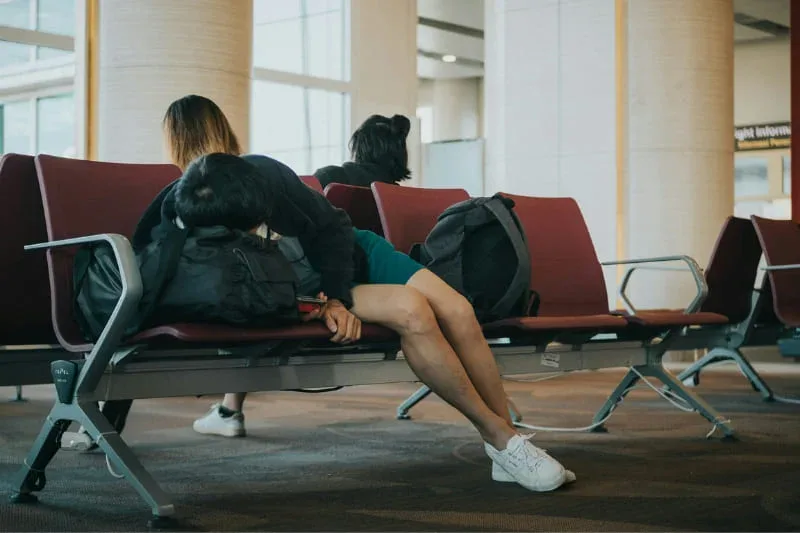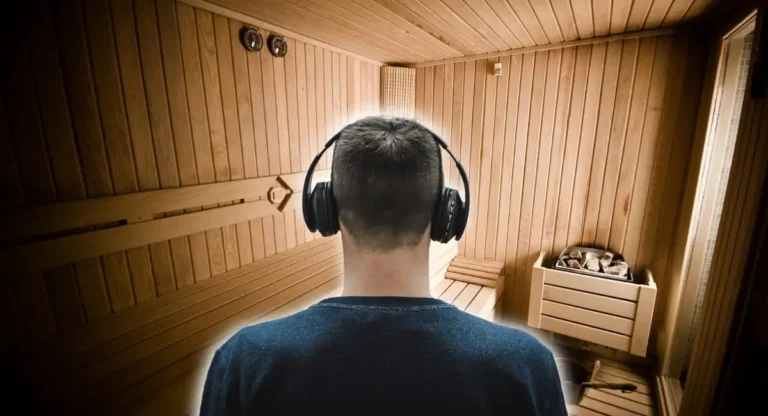Why Pilots Use Sauna for Jet Lag (And Why You Should Too)

Key Takeaways
- Sauna sessions may improve sleep quality after crossing time zones
- Heat therapy activates heat shock proteins that help with physical recovery
- Studies show saunas can reduce travel stress and improve circulation
- Infrared saunas operate at lower temperatures, making them easier to use when tired
- Real travelers report significant jet lag relief from post-flight sauna sessions
Does your body feel like it’s midnight when the local clock says noon? Jet lag happens when your internal clock doesn’t match the time zone you’re in.
While many travelers rely on melatonin pills or careful light exposure to adjust, sauna therapy is emerging as a helpful addition to jet lag recovery plans.
Table of Contents
MEDICAL DISCLAIMER: The information provided in this article is for educational purposes only and is not intended as medical advice. Always consult with a qualified healthcare professional before starting any new health regimen, including the use of saunas.
4 Science-Backed Sauna Benefits for Jet Lag Relief
1. Better Sleep Quality
The most frustrating part of jet lag? Not being able to sleep when you need to. Research shows sauna sessions may help fix this problem.
A 2019 study published in Complementary Therapies in Medicine found that 83.5% of regular sauna users reported improved sleep quality, with benefits lasting for 1-2 nights after each session. 1
When you experience the warming effect of a sauna, your body temperature rises during the session and then drops afterward. This temperature drop mimics your body’s natural cool-down before sleep, potentially helping you fall asleep faster and sleep more deeply—exactly what your jet-lagged body needs.
Related Article: Sauna for Sleep
2. Reduced Travel Stress
Ever notice how tense your body feels after a long flight? Sauna heat works as a natural stress reliever.
A 2018 systematic review in Evidence-Based Complementary and Alternative Medicine showed that regular sauna use can lower cortisol (your main stress hormone) and trigger the release of endorphins—your body’s natural feel-good chemicals. It concluded that frequent sauna bathing is linked to reduced stress and improved mental wellbeing. 2
Since high stress levels make adapting to new time zones harder, anything that lowers your stress can help you adjust faster.
3. Improved Circulation After Flying
Sitting in a plane for hours isn’t just uncomfortable—it can lead to poor blood flow and swollen legs and feet. Sauna heat opens up your blood vessels, improving circulation throughout your body.
Research published in the Canadian Family Physician Journal found that infrared saunas improve blood flow and can help normalize blood pressure. 3
This increased circulation may help your body eliminate waste products that build up during long flights, making you feel more energetic faster.
4. Heat Shock Proteins: Your Body’s Recovery System
Here’s where sauna benefits get really interesting at the cellular level. When your body heats up in a sauna, it produces special proteins called heat shock proteins (HSPs). These proteins act like cellular repairmen, helping damaged proteins refold correctly and removing ones that can’t be fixed.
A 2021 study in Experimental Gerontology showed that sauna use triggers HSP production4, which can:
- Speed up physical recovery
- Protect cells from stress damage
- Fight inflammation throughout the body
- Boost your immune system
For travelers, this means sauna sessions might help your body recover faster from the physical stress of flying and adapt more quickly to your new time zone.
Related Article: Sauna and Heat Shock Proteins

Infrared vs. Traditional: Best Sauna Type for Travelers
| Feature | Infrared Sauna | Traditional Sauna |
|---|---|---|
| Temperature | Lower (120-140°F) | Higher (160-200°F) |
| Tolerance when tired | Easier to handle | More intense |
| Heat penetration | Deep (1-2 inches) | Surface level |
| Availability while traveling | Less common | More common in hotels/gyms |
Key Differences for Jet Lag Recovery
Infrared saunas use light waves to heat your body directly, rather than heating the air around you. This means:
- You sweat at lower temperatures
- The heat reaches deeper into tissues
- Sessions can be more comfortable when you’re already tired from travel
Traditional saunas create a hotter environment and may be easier to find in hotels and gyms worldwide. They heat the air around you, creating a more intense experience that some travelers prefer for clearing their heads after a long flight.
Related Article: Infrared vs Traditional Sauna
Real Travelers’ Experiences with Sauna for Jet Lag
Airline Pilot’s Perspective
Doyle Tonneson, an international airline pilot who regularly flies 8+ hour routes, calls his infrared sauna “a game changer” for his post-flight recovery routine.
“I make it a priority when returning home from a trip to always get in a sauna session for at least 30 minutes before I tackle anything else,” he explains. “I’ve found the infrared heat automatically increases my melatonin production – helping me sleep better between flights.”
Wellness Traveler’s Experience
A writer for Lux Nomade visited Bionik Wellness in Sydney after a brutal 28-hour journey from England and reported remarkable results from a multi-step approach that started with an infrared sauna session.
“The first step in my jet lag curing journey was an infrared sauna – chosen not only for its relaxation effect but also for its function as a vasodilator,” the writer noted. After completing the treatment protocol, the writer “slept through from 9 pm until 5:30 am and watched the sunrise from the ocean – England’s time zone a distant memory.”
Travel Wellness Expert Recommendation
Health professionals at High Tech Health recommend specific timing for sauna sessions when dealing with jet lag:
“Schedule a sauna session shortly after reaching your destination to kickstart relaxation and help your body adjust.” They also suggest “using the sauna a few hours before bedtime to enhance sleep quality by triggering your body’s natural cooling process afterward.”

Practical Sauna Protocol for Jet Lag
When to Use Sauna for Maximum Benefit
For westward travel (e.g., USA to Asia):
- Use the sauna in the early evening of your arrival day
- This helps extend your wakefulness until local bedtime
For eastward travel (e.g., Europe to USA):
- Use the sauna in the late afternoon of arrival day
- This helps reset your body clock to fall asleep earlier
Wait at least 2-3 hours after landing before your first sauna session to give your body time to rehydrate.
Optimal Sauna Session Guidelines
For best results when jet-lagged:
- Start with shorter sessions (15-20 minutes)
- Choose moderate temperatures (120-160°F depending on sauna type)
- Drink plenty of water before, during, and after
- Exit the sauna if you feel dizzy or uncomfortable
Remember: Your body is already stressed from travel, so be gentler than you might normally be with heat exposure.
Combining with Other Jet Lag Remedies
Sauna therapy works best as part of a complete jet lag recovery plan:
- Morning bright light exposure helps reset your circadian rhythm
- Stay hydrated throughout your flight and after landing
- Eat meals on local time as soon as possible
- Take a short walk outdoors after your sauna session
- Avoid alcohol and caffeine for 4-6 hours before bedtime
The Verdict on Sauna for Jet Lag
While sauna therapy isn’t a magical jet lag cure, the science suggests it can help ease your transition between time zones. The combination of improved sleep, reduced stress, better circulation, and cellular-level recovery makes it worth trying on your next long-haul trip.
Start with a short, gentle session after you arrive at your destination, stay hydrated, and pair your sauna with other jet lag remedies like light exposure and proper meal timing. Your body might thank you by adjusting to the new time zone faster than ever.
Struggling with jet lag disrupts your travel experience, but adding sauna therapy to your recovery plan could help you enjoy your destination from day one.
Resources
- Hussain, J. N., Greaves, R. F., & Cohen, M. M. (2019). A hot topic for health: Results of the Global Sauna Survey. Complementary therapies in medicine, 44, 223–234. https://doi.org/10.1016/j.ctim.2019.03.012 ↩︎
- Hussain, J., & Cohen, M. (2018). Clinical Effects of Regular Dry Sauna Bathing: A Systematic Review. Evidence-based complementary and alternative medicine : eCAM, 2018, 1857413. https://doi.org/10.1155/2018/1857413 ↩︎
- Beever R. (2009). Far-infrared saunas for treatment of cardiovascular risk factors: summary of published evidence. Canadian family physician Medecin de famille canadien, 55(7), 691–696. ↩︎
- Patrick, R. P., & Johnson, T. L. (2021). Sauna use as a lifestyle practice to extend healthspan. Experimental gerontology, 154, 111509. https://doi.org/10.1016/j.exger.2021.111509 ↩︎

“Become a Sauna Expert Overnight!”
Grab Your “FREE” Sauna E-book NOW!
Get your hands on the ultimate sauna manual. From history to DIY setups, our free guide has it all.

As a Chartered Accountant turned sauna enthusiast, I bring a unique blend of analytical skills and hands-on experience to the world of heat therapy. With over a decade dedicated to researching and testing sauna products and practices, I’ve developed a deep understanding of this field. A the founder of HomeInDepth.com, I provide reliable, easy-to-understand information on all aspects of saunas. My goal is to guide you through every step of your sauna journey, offering meticulously researched, unbiased advice to help you make informed decisions and create your perfect sauna experience. I’m always happy to hear from sauna lovers like you—feel free to leave questions or share your own tips in the comments below so we can learn together. Contact me on:






